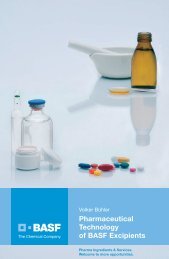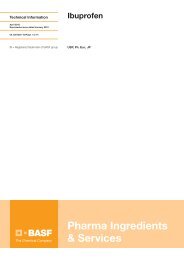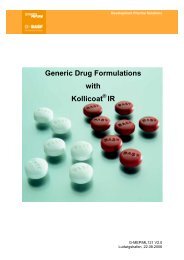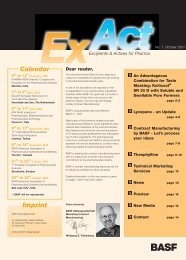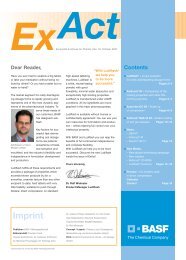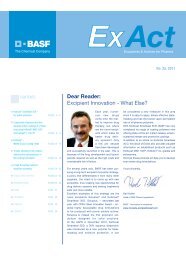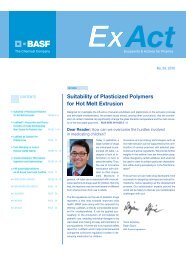Dear Reader: Innovations across the entire package - Pharma ...
Dear Reader: Innovations across the entire package - Pharma ...
Dear Reader: Innovations across the entire package - Pharma ...
You also want an ePaper? Increase the reach of your titles
YUMPU automatically turns print PDFs into web optimized ePapers that Google loves.
Excipients & Actives for <strong>Pharma</strong><br />
No. 26, 2011<br />
STABILITY OF FORMULATED OXYGEN-SENSITIVE ACTIVE INGREDIENTS<br />
Extended stabilization of active ingredients highly sensitive<br />
to oxidation using Kollidon 30 LP<br />
Angelika Maschke, Karl Kolter<br />
INTRODUCTION | <strong>Pharma</strong>ceutical formulators<br />
regularly require a low peroxide content in<br />
<strong>the</strong> excipients used to avoid degradation of <strong>the</strong><br />
active ingredients (APIs) used. BASF fulfils this<br />
need to <strong>the</strong> maximum extent with its high-quality<br />
Kollidon grades and <strong>the</strong> packaging concept<br />
introduced in this ExAct issue (see pages 2-4).<br />
Moreover, <strong>the</strong> formulation of drugs that are<br />
highly sensitive to oxidation has become an<br />
additional major challenge for formulation scientists.<br />
For this purpose, it is of <strong>the</strong> utmost importance<br />
to use excipients with an especially<br />
low peroxide content.<br />
Considering <strong>the</strong> close contact between active<br />
ingredients and excipients during wet granu lation<br />
or direct compression, <strong>the</strong> peroxide level of <strong>the</strong><br />
excipient has a strong impact on <strong>the</strong> stability<br />
of <strong>the</strong> API. As a first formulation approach, <strong>the</strong><br />
stability of <strong>the</strong> API in a binder solution allows<br />
<strong>the</strong> appropriate binder to be identified. The goal<br />
of this study was to investigate <strong>the</strong> effect of <strong>the</strong><br />
peroxide content of povidone on API stability in<br />
solution.<br />
Using Kollidon 30 LP in<br />
<strong>the</strong> formulation of actives<br />
highly sensitive to<br />
oxidation can significantly<br />
improve drug stability.<br />
Set-up of experiments The effect of Kollidon<br />
30 Low Peroxide in solution on stabilization<br />
against oxidation was investigated using ascorbic<br />
acid and hydrocortisone as model substances.<br />
Povidones of different peroxide content (see<br />
table 1) were used to prepare a 20% aqueous<br />
solution. Ascorbic acid was incorporated at a<br />
0.1% level and hydrocortisone at 0.025%.<br />
For <strong>the</strong> stability study, <strong>the</strong> samples were filled<br />
in glass vials incubated with or without argon,<br />
closed with a rubber cap and sealed with a<br />
cramp. The solutions were stored for 3 months at<br />
25°C and 60% relative humidity. The API content<br />
was determined by HPLC.<br />
Results Both drug substances showed higher<br />
stability in solutions prepared with Kollidon 30 LP.<br />
After 1 month in Kollidon 30 LP solution, <strong>the</strong><br />
ascorbic acid content was 50% vs. 30% in a<br />
PVP solution with a starting peroxide level of<br />
< 260ppm (Figure 1). A similar stabilization effect<br />
was found for hydrocortisone solutions<br />
(Figure 2).<br />
Povidone<br />
Peroxide content<br />
Kollidon 30 LP Very low < 20 ppm<br />
PVP 30 Low < 260 ppm<br />
PVP 30 Enriched 370 ppm<br />
TABLE 1<br />
Povidone grades used for preparing aqueous acid solutions<br />
Page 11



